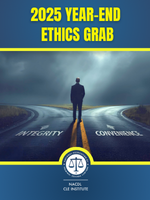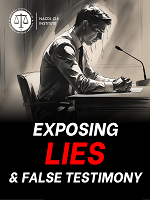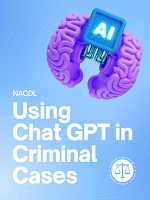Access to The Champion archive is one of many exclusive member benefits. It’s normally restricted to just NACDL members. However, this content, and others like it, is available to everyone in order to educate the public on why criminal justice reform is a necessity.
As a new year dawns, it should be of interest to NACDL members and other readers of The Champion to highlight six of the Association’s groundbreaking achievements of the past year. For context, it is useful to restate NACDL’s core goals:
- Ensure justice and due process for all.
- Foster integrity, independence, and expertise of the criminal defense bar.
- Promote the proper and fair administration of justice.
- Promote rational and humane criminal justice systems.
NACDL pursues these goals by focusing on three fundamental objectives: education, resource support, and public policy advocacy. In 2014, NACDL educated nearly 6,500 lawyers, including more than 3,000 at one of a dozen live CLE programs conducted on various topics at venues throughout the nation. More than 30 webinars attracted several thousand viewers on topics that cover the entire gamut of criminal justice issues. Many of these programs are free, and for programs that require registration fees, NACDL has launched an ambitious scholarship program to facilitate program attendance for public defenders and private attorneys who serve the indigent accused.
NACDL also maintains a keen focus on providing resource support for members. Through several discussion groups, NACDL members can instantly obtain expert guidance and input from colleagues on the vexing issues that inevitably arise in daily practice. The Daily Criminal Justice Briefing provides a handy compendium of all major criminal justice developments. The Resource Center and other Web features provide invaluable tools to keep members abreast of legal developments, as does the availability of Resource Counsel Vanessa Antoun, who responds to hundreds of inquiries annually. A monthly Enews highlights major new developments affecting the criminal justice system. And NACDL provides direct assistance to lawyers through its robust amicus program, the Lawyers Assistance Strike Force, and a direct Web link for lawyers suffering from stress or personal crisis.1
When it comes to public policy advocacy, however, NACDL endeavors not just to support criminal defense lawyers and the clients they serve, but also seeks to promote systemic reform by addressing flaws in the criminal justice system. NACDL’s members, leaders, and staff collaborated in 2014 to produce six major reports and proposals — all designed to address broad systemic injustice.
First, recognizing that a pervasive and recurring contributor to injustice is the superficial manner in which many media outlets cover criminal justice issues, NACDL, with support from the Foundation for Criminal Justice and the Park Foundation, produced a series of tutorial videos aimed at assisting journalists interested in covering the criminal justice system. Criminal Justice and the Media is a three-part series exploring how journalists can effectively and accurately inform the public about developments in the criminal justice system, which is one of the most important and pervasive forces in American society. Some of the finest journalists in the country joined with NACDL to create this illuminating video series that describes how first-rate journalists cover criminal trials, criminal appeals, and criminal justice policy issues. The series is available at no cost on NACDL’s website at http://www.nacdl.org/coveringcriminaljustice, and the Association sent DVD box sets of the videos to journalism and communication program deans, libraries, and selected professors (undergraduate and graduate) across the nation.
In Part II of the Gideon at 50 report — titled Redefining Indigence: Financial Eligibility Guidelines for Assigned Counsel — NACDL tackled the increasing tendency of states and localities to create obstacles to access counsel for people of limited financial means.2 This 50-state survey documents how states decide who is “too poor” to hire a lawyer. The survey looks at how states define “indigency” and whether or not the definition is consistent with ABA standards for providing defense services. It identifies which states rely on the Federal Poverty Guidelines when determining eligibility for assigned counsel, and it explains the origin of the Federal Poverty Guidelines and how they cannot accurately predict who is “too poor” to hire a lawyer. The survey then looks at the fees and costs imposed on supposedly indigent defendants who are assigned counsel. These include application fees (payable at the time a request for counsel is made) and reimbursement fees (payable at the conclusion of the case or over time). The report concludes that in adopting unduly restrictive eligibility criteria and other policies, too many states have been able to ignore the central premise of Gideon that “lawyers in criminal courts are luxuries, not necessities.”
NACDL continues to place a high priority on ensuring the vitality of the Fourth Amendment in an era of increasing technological capacity to undermine privacy. What’s Old Is New Again: Retaining Fourth Amendment Protections in Warranted Digital Searches (Pre-Search Instructions and Post-Search Reasonableness)is NACDL’s latest effort to promote reforms,policies, and practices to restrain law enforcement abuse.3 This white paper focuses on law enforcement searches of digital evidence, and provides nine recommendations for reform to the judiciary, legislatures, and law enforcement entities. A key provision is to require pre-search restrictions in a warrant for digital evidence, including a waiver of the plain view doctrine, requiring law enforcement to secure a warrant if evidence of an unrelated crime is discovered during the search, and a suppression remedy if the pre-search requirements are not met.
After nearly three years of study by NACDL’s Task Force on the Restoration of Rights and Status After Conviction, including hearings in various locations around the country that featured more than 150 witnesses, NACDL released a groundbreaking report on the impact of collateral consequences: Collateral Damage: America’s Failure to Forgive or Forget in the War on Crime — A Roadmap to Restore Rights and Status After Arrest and Conviction.4 The report documents the life-altering impact of the silent sentences and hidden penalties that are inflicted upon individuals who have had a brush with the criminal law. Through the stories of countless witnesses from every realm of the criminal justice system, including those who have faced barriers and debarments that are often unfair and irrational, Collateral Damageis a comprehensive manifesto for change. The report includes a series of tangible recommendations aimed at state and local governments, criminal justice system actors, and the population at large. The overarching goal is to promote the full restoration of rights, and to fundamentally alter the national mindset toward the more than 65 million Americans who have a criminal record.
As every criminal defense lawyer knows from bitter firsthand experience, discovery abuse and the suppression of favorable evidence remain among the greatest contributors to injustice. In 2014, NACDL produced two separate initiatives designed to lay a foundation for sustained reform efforts in the coming years. In May, NACDL’s Board of Directors approved model discovery legislation with the stated purpose being “to ensure the fairness and finality of criminal trials and guilty pleas by requiring that the accused in every criminal prosecution shall receive, promptly after arraignment, on a timely basis thereafter, and prior to any plea agreement, all information within the possession of the prosecutors, law enforcement agencies, and other investigatory agencies involved in case investigation and prosecution.” Essentially, this is a model open-file discovery law that includes reasonable safeguards for privileged material and witness safety.5
Finally, in November, NACDL joined forces with the Veritas Initiative and the Santa Clara University School of Law to publish a major research report documenting how the materiality standard articulated in Brady6 has actually contributed to a pervasive pattern of nondisclosure. Material Indifference: How Courts Are Impeding Fair Disclosure in Criminal Cases studied how courts adjudicate Brady violation claims.7 Through a randomized, methodical study of cases adjudicating such claims in federal courts over a period of five years, the report found that regardless of how the materiality standard is articulated, courts tend to apply it in an arbitrary and unpredictable manner.8 Further, the report statistically documented that materiality determinations significantly favor the prosecution, and tend to insulate nondisclosure from meaningful redress. The inescapable conclusion is that the judiciary is impeding fair disclosure in criminal cases and, in doing so, encouraging prosecutors to disclose as little favorable information as possible.
Material Indifference concludes with several remedial recommendations, including steps that lawyers can take immediately to ensure prosecutorial compliance by invoking ethical obligations, measures that the judiciary can adopt to ensure prompt disclosure, and proposals for legislative reform. Within days of the release of the report, Sen. Lisa Murkowski of Alaska issued a statement in which she reacted to the report by indicating that she plans to re-introduce the Fairness in Disclosure of Evidence Act, remedial legislation strongly supported by NACDL.9
With each of these projects, NACDL has not only studied and reported on a problem, but has also established a framework from which to pursue a reform agenda. NACDL’s leadership and staff are already engaged in strategies and initiatives designed to achieve progress in each area that was a focus of its work in 2014. It is through these efforts that the Association will continue to serve the needs of its membership, the broader defense function, and the millions who are impacted every year by the nation’s criminal justice system.
Notes
- The NACDL website provides links to a national network of lawyer assistance resources maintained by the ABA’s Commission on Lawyer Assistance. Go to http://www.americanbar.org/groups/lawyer_assistance.html.
- http://www.nacdl.org/reports.
- Id.
- Id.
- The model discovery legislation is available at http://www.nacdl.org/resolutions/2014sm02/.
- Brady v. Maryland, 373 U.S. 83 (1963).
- http://www.nacdl.org/reports.
- Although the study focused on federal court decisions, many of the cases involved federal challenges to state convictions, and thus the litigation focused on the actions of state prosecutors.
- The senator observed, “Though Attorney General Eric Holder threw Ted Stevens’ guilty verdict out of court because Department of Justice attorneys played ‘hide the football’ with evidence that could have helped his case, he only dealt with the symptom and allowed the problem to linger among the legal ranks. I hope that his successor will truly commit to uprooting this issue that is undercutting Americans’ faith in the judicial branch, and plan to re-introduce my bipartisan Fairness in Disclosure of Evidence Act in the next congressional session. We can no longer allow the government to have a finger on the scales of justice, tipping it in its favor.” (http://www.murkowski.senate.gov/public/index.cfm/pressreleases?ID=5e17e50b-cd3e-4485-895d-749efb0a39fc).
About the Author
Norman L. Reimer is NACDL’s Executive Director and Publisher of The Champion.
Norman L. Reimer
NACDL
1660 L Street, NW, 12th Floor
Washington, DC 20036
202-465-7623
Fax 202-872-8690
nreimer@nacdl.org













